Part 2 of an occasional series. Rings in my Etsy shop that remind me of things …
Part 1 was a ring that reminded me of an Iron Age hillfort …
UPDATE: 28 October 2015 – the ring has now sold. Sorry!
Part 2 of an occasional series. Rings in my Etsy shop that remind me of things …
Part 1 was a ring that reminded me of an Iron Age hillfort …
UPDATE: 28 October 2015 – the ring has now sold. Sorry!
Every now and then I hear a piece of music that is so distinctive that whenever I hear it subsequently I know it immediately. One of these earworms for me for a Norwegian folk song called ‘Den Bortkomne Sauen’—‘The Lost Sheep’.
I first heard this melody while watching the marvellous Coen Brothers film Fargo, which was released in 1996. The main theme of the film is an adaptation by Carter Burwell of ‘Den Bortkomne Sauen’.
Such a distinctive melody, which seemed to echo so well the icy landscapes of northern Minnesota—a wintery land populated by people of Scandinavian extraction where horrible murders happen, wood chippers optional, and heavily-pregnant police chiefs doggedly pursue their man. The music stuck with me, a lovely earworm I didn’t expect to hear again.
Fast forward a few years. I listen to a lot of BBC Radio 4 while I work, and I particularly enjoy the afternoon dramas. One set of plays that grabbed me right from the start was the Pilgrim series by Sebastian Baczkiewicz, the first episode broadcast in 2008 and now five series in. The stories involve William Palmer, a 12th century immortal cursed to wander the modern British countryside, encountering faeries and demons as well as hoodies and housewives. And lo! Used in Pilgrim was ‘Den Bortkomne Sauen’, a version played by Norwegian musician Annbjørg Lien on her Hardanger fiddle, accompanied by a church organ:
The later Fargo version, with its syrupy harp at first and rather overblown orchestration after the fiddle part, has wonderfully slow tempo, full of foreboding. Annbjørg’s 1994 version is plaintive and stripped-down, but at a slightly faster tempo, and I could really sense the lost sheep in the icy Nordic snowdrifts as she played. It also fitted perfectly with the theme of Pilgrim, with Palmer the lost soul condemned to wander forever.
Annbjørg’s version is available on her album Felefeber (‘Fiddle fever’), released in 1994, and available on Amazon. Series 3 of Pilgrim was awarded the Silver Medal for the Best European Radio Drama of the Year at the Prix Europa in Berlin, and nominated for the Prix Italia Best Original Radio Drama award. It’s a great listen if you get the chance. As one other listener described it so well: ‘I love the way one world settles seamlessly in-between the cracks of another’, and in that same post Sebastian has confirmed that Series 6 and 7 have been commissioned, hurrah!
And then earlier this year, I was delighted to see/hear that the title track of the 2014 television series adaptation of Fargo, which I hugely enjoyed, had nods to ‘Den Bortkomne Sauen’ and its use in the original film:
I haven’t seen it yet, but apparently ‘Den Bortkomne Sauen’ also crops up in the Norwegian tv series Lilyhammer (and no, that’s not a typo). I am definitely going to catch up on this one as it is a Norway-set mash-up of The Sopranos (my all-time favourite tv series) and Scandinoir, with a good dash of comedy thrown in, and stars Steven Van Zandt as Frank, an Italian-American mafioso relocated by the Federal Witness Protection Program to Lillehammer. Frank even picks up a lost sheep in the very first episode, so I read.
Update 22 December 2014: A new series of Pilgrim has just started this afternoon on Radio 4. The Beeb hasn’t exactly gone overboard with publicising it, as the first I heard about it was when I was listening to the radio and it started! But hurrah, more, new Pilgrim!
My heart is in the past, and that is why I love this website: Britain From Above. In 2007 English Heritage, the Royal Commission on the Ancient and Historical Monuments of Scotland (RCAHMS), and the Royal Commission on the Ancient and Historical Monuments of Wales (RCAHMW) acquired the historic oblique aerial photography archive of Aerofilms, a company set up in 1919 for commercial photography from the air. Usually the photos were taken for clients, maybe to establish the location of a building plot within the landscape, or to show the progress of a large construction site or the condition of a property, or as views to be sold to postcard manufacturers, but they have other significances too: the most important part of the collection spans the years from 1919—1953, and document a now-lost England, Wales and Scotland (sadly Northern Ireland is not part of the project). Currently there are over 96,000 digitised images in the collection.
I can—and do—lose hours on the Aerofilms website. If you register as a member (it’s very easy to do so, and free), you are able to zoom in on the photographs. The negatives have been scanned at such a high resolution that the tiniest details become clearly visible. They show snapshots of a long-lost Britain: stooks of wheat in a field after harvest; horse-drawn ploughs; airmeets for the dashing 1920s and 1930s aviators where planes are simply landed in a suitable flat field; steam engines puffing along pre-Beecham railway lines; film sets from the 1930s; even the R-101 on its first test flight. You can search by date, by co-ordinate, or by placename.
The project encourages users to contribute information on places by tagging the images or adding data, photos, videos or links in a free text area. There are galleries which include all the images taken on a single flight, and even a gallery for so-far unidentified images, where the information accompanying them is lost or incorrect, and members have helped successfully re-attribute many of the photos in the collection. Some of the photos are on glass plate negatives which have been damaged—yet another reminder of a lost time.
Many of the photos are of cities and built-up areas, but as my heart is in the countryside as well as in the past, I tend to stick to looking at the photos of rural areas.
I have used Britain From Above for my archaeological research work: sometimes I undertake projects where I have to find out as much as I can about a particular area or site, and how it has developed over time. For this I will use documentary sources (books and articles, plus written documents such as letters, wills, diaries, estate accounts etc), maps and plans, drawings, paintings and sketches, and where available, photographs. The Aerofilm vertical photos at 1:10,000 scale are an amazing resource for identifying landscape features such as earthworks, and the oblique photos on Britain From Above are also very useful as they are often taken from a much lower altitude and so have much more detail. Earlier this year I worked on a project for the history of a house and plot near to Hampton Court Palace in Richmond upon Thames, London: the Aerofilm photos provided great details about its development from the 1920s onwards.
Britain From Above is a fantastic resource (especially for schools) and a complete time-sink. Once I log on, that’s it for a couple of hours …
I’ve been meaning to write about Wilton House for a while, but was spurred on today when I sold a little brooch in my Etsy shop. I sent a thank-you notecard with the order, one from a set I’d bought many years ago from the Wiltshire Records Office (as was: now the Wiltshire and Swindon History Centre), and the one I chose featured a late 18th century engraving of Wilton House:
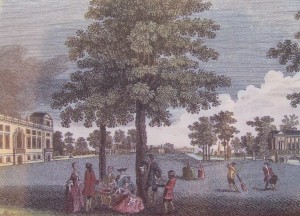
Wilton House. Late 18th century engraving, showing the south front of the house on the left and the Palladian Bridge on the right.
(Or perhaps more accurately, an engraving of a couple of lovely trees and a party of people, with a section of Wilton House and the Palladian Bridge lurking in the background.)
I regularly drive past the impressive gates of Wilton House—so regularly that I’ve almost stopped noticing them. Not an easy feat: just look at them! Isn’t it terrible to take something so spectacular so for granted?
Unlike many of the other grand houses I’ve written about, Wilton House is still a family home, the seat of the Earls of Pembroke for the last 400 years. The first building on the site was a priory founded in c. 871 AD; the first Earl of Pembroke took possession of the site in 1542. Relatively little of the first, Tudor house survives: what is visible today is mostly the Palladian building of the 1630s and 1640s, designed with the involvement of Inigo Jones, and later alterations by James Wyatt in the early 19th century.
The interiors of Wilton House are sumptuous, and among the state rooms designed by Inigo Jones are the Single Cube Room (measuring 30 feet (9.14 m) long, wide and high, and the Double Cube Room, which is 60 feet (18.29 m) long and 30 feet (9.14 m) wide and high.
The grounds and gardens are beautiful, with one of only a handful of Palladian bridges in the country, built over the River Nadder.
Such stunning locations have not surprisingly been used a lot in movie and television filming.
There is a much more comprehensive list on the Wilton House website location filming page.
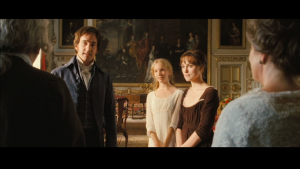
A scene from Pride and Prejudice filmed at Wilton House in the Double Cube Room.
Update 10 August 2015: I’ve just learned that the television series Outlander has just finished two weeks’ filming at Wilton House, which is standing in for the Palace of Versailles. Apparently the British furniture and furnishings were moved out, and appropriate French ones were moved in for the duration of the filming. Plus the candle budget was £1000 a day! Simon Callow was one of the actors.
December 2016 update: I always seem to have Viking ship jewellery in my shop. Click here to see the current selection.
More by accident than design—and a very happy accident at that—I have three Viking ship brooches in my Etsy shop at the moment. I think they show longships, as opposed to the other kinds of Viking sea-going vessels.
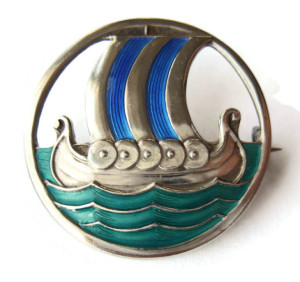
Fabulous David-Andersen Viking ship brooch, dated to between 1924 and 1939. For sale in my Etsy shop: click photo for details. (NOW SOLD).
The jewel in the crown is an exquisite silver and enamel brooch by the renowned Norwegian firm of David-Andersen. The craftsmanship in this piece is stunning, and shows why David-Andersen enamelwork is so highly thought of.
The brooch can be dated quite closely to between 1924 and 1939, as the combination of 925 (sterling) silver and a particular form of the maker’s mark for the company was only used in this period. This brooch design is rarely seen and so is highly collectable.
The second Viking ship brooch dates from 1946 and was made by the Birmingham firm of Shipton and Co. It is solid sterling silver and was hallmarked in Chester (I wonder why a Birmingham firm didn’t send their silver to the Birmingham Assay Office to be hallmarked, rather than the Chester one?). It is very reminiscent of the popular Iona silver Celtic-style jewellery, made famous by designer Alexander Ritchie:
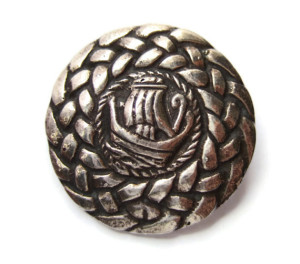
Sold sterling silver Viking ship brooch, made by Shipton & Co of Birmingham and hallmarked 1946 in Chester. For sale in my Etsy shop: click photo for details. (NOW SOLD).
The third brooch is also the youngest one: it was made by famous silversmith Malcolm Gray of the Ortak silversmithing firm on the Orkney Islands, and hallmarked at the Edinburgh Assay Office in 1981:
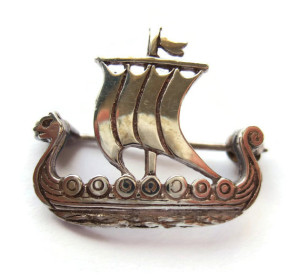
Sterling silver Viking longship brooch by Malcolm Gray of Ortak, hallmarked Edinburgh 1981. For sale in my Etsy shop: click photo for details. (NOW SOLD). September 2015 update: I have another of these for sale, also from 1981. Click on photo for details. (NOW SOLD).
This brooch is also solid sterling silver. The hallmarks and Gray’s maker’s mark are tiny, and barely visible among the textured dimples on the back of the brooch. The choice of subject matter is a fitting one, for the Vikings were an integral part of the history of these islands. The people of the Shetland Islands, north of the Orkneys, remember their Viking heritage every year with the Up Helly Aa festivals, and one day Chap and I are going to make it up there to see the festivities.
Update 22 June 2015: I have a new Viking ship brooch, by Aksel Holmsen of Norway, and dating from the 1930s:
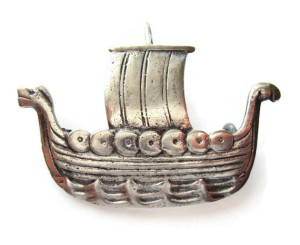
Viking ship brooch in 830 silver, by Aksel Holmsen of Norway. For sale in my Etsy shop: click on photo for details. (NOW SOLD).
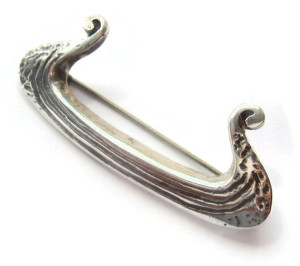
Malcolm Gray Ortak sterling silver Viking ship brooch, 1975. For sale in my Etsy shop: click on photo for details. (NOW SOLD).
September 2015 update. A couple more Viking ship brooches:
A Shetland Silvercraft brooch from 1968:
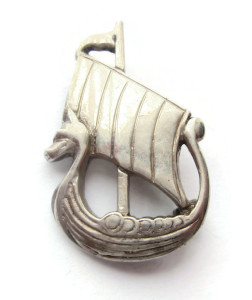
Sterling silver Viking ship brooch by Shetland Silvercraft, 1968. For sale in my Etsy shop: click on photo for details. (NOW SOLD).
and a tiny mystery:
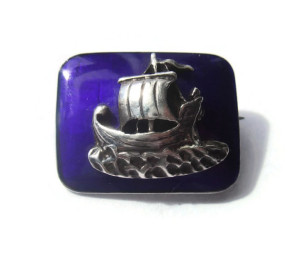
Tiny enamel and sterling silver Viking brooch. For sale in my Etsy shop: click on photos for details. (NOW SOLD).
And finally, I just had to end with a clip from a great Saturday tea-time favourite film of mine when I was a kid: The Vikings (1958), starring Kirk Douglas, Tony Curtis, Janet Leigh and Ernest Borgnine.
We are so lucky to live close to the beautiful landscape gardens of Stourhead, near Mere in south-western Wiltshire. Chap and I visit often, and we are about due another visit to see the gorgeous autumn colours there.
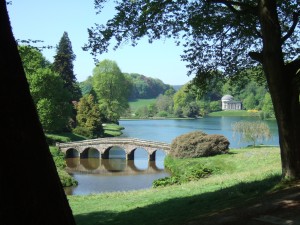
Stourhead. The Palladian Bridge in the foreground and the Pantheon on the other side of the lake. Photo taken April 2011 by Inglenookery.
The house at Stourhead was built by Henry Hoare between 1721—1725, and the gardens were developed soon afterwards. They were brought into greatness in the mid-eighteenth century by Hoare’s son Henry Hoare II, with the damming of the small River Stour to form the lake, the building of the various temples, planting of the trees and development of the landscape features.
Stourhead Estate is managed by the National Trust. The charity’s properties are often used for filming, especially for period pieces (I’ve previously written about Montacute House, Mompesson House and Saltram House).
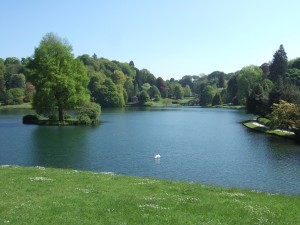
Stourhead. View from the Pantheon looking across the lake to the bridge and the Temple of Flora. The Temple of Apollo is on the high ground to the right of the photo. Photo taken April 2011 by Inglenookery.
Stourhead is more famous for its gardens than its associated Palladian mansion, and I am always surprised at how little it has been used as a location for filming. Part of the reason might be that it is one of the Trust’s most popular properties, with the gardens open every day apart from Christmas Day and New Year’s Day. Even though it has many visitors every day, the gardens are so large that they rarely feel crowded. In 2012—2013 it was the most visited NT property for which a charge is made, with 356,023 visitors (other open country sites in NT ownership, such as Avebury or the Coastal Paths, are free to visit and so counts of visitor numbers are not easily available.)
I can only think of it appearing in two films: the 2005 film adaptation of Pride and Prejudice, in the scene when Mr Darcy (Matthew Macfadyen) first proposes to Elizabeth Bennet (Keira Knightley), filmed in the rain at the Temple of Apollo, and the brief scene with Elizabeth running across the five-arched bridge over the lake; and the scene in Barry Lyndon, the 1975 film directed by Stanley Kubrick, where Barry (Ryan O’Neal) talks to his mother (Marie Kean) on the bridge, with the lake and the Pantheon in the background in some shots, and the Temple of Flora in the background in another. There must be others, I’m sure—I just can’t think of any.
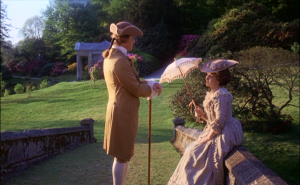
Barry Lyndon (Ryan O’Neal) with his mother (Marie Kean) on the bridge at Stourhead, with the Temple of Flora in the background.
We we very lucky when we visited in September last year—the Festival of the Voice was taking place, and it was magical to hear unaccompanied choral works drifting in the air as we walked around the garden. We stopped at the Pantheon to listen to this (apologies for it being filmed sideways on. I have no idea a) how to film or b) how to edit …)
Today I watched the 1995 Ang Lee directed film of Sense and Sensibility again. I haven’t watched it for years and had forgotten what a good adaptation it is, and how sumptuous the filming locations are. It was mainly filmed in various stately homes and estates in Devon, Somerset and Wiltshire—my favourite part of the world (along with Dorset), so there’s no way I’m not going to love this film! I wrote a previous post about how I was lucky enough to watch just a tiny bit of the filming back in 1995, outside Mompesson House in Salisbury. In spring this year we visited one of the other filming locations, Saltram House, while Chap and I were staying with my younger sister and her hubby in Devon. To our shame Chap and I had never visited before, despite having driven past it too many times to mention. Like Mompesson House, Saltram is owned by the National Trust.
In the film, Saltram House stands in for Norland Park, the home of the Dashwoods before they are forced to leave after Mr Dashwood’s death.
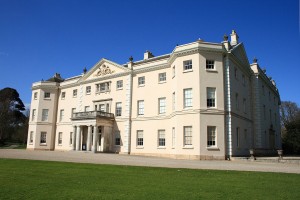
Saltram House, just outside Plymouth in Devon. The stand-in for Norland Park in the 1995 film Sense and Sensibility. Photo by Chilli Head.
We took a long walk around the grounds but didn’t have time to look around inside the house, so I have no idea whether the interior scenes set at Norland Park were filmed at Saltram too (given that both the interior and exterior scenes of Mrs Jennings’ townhouse were filmed at Mompesson House, I’m guessing it’s likely that they were).
The grounds are beautiful, if perhaps a little spoiled by the road noise from the nearby A38, and go down to the River Plym. Margaret’s wonderful treehouse in the film is no longer there, but the estate is beautifully kept, with many old and interesting trees.
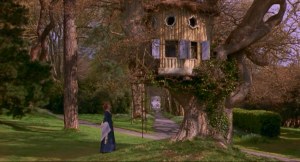
Margaret Dashwood’s treehouse in the film Sense and Sensibility, filmed at Saltram House. The avenue beyond leads to the house.
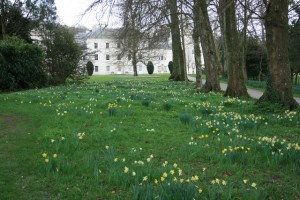
The avenue leading to the house. Margaret’s treehouse is at the end of this, and Elinor and Edward Ferrars go for a walk along it in the film. Photo by Adrian Platt.
The orangery was filled with citrus trees in pots, and pots stuffed full with clivias. The stables, where in the film Elinor almost gets a profession of love from Edward Ferrars (drat his pesky sister for coming along just when she did), were alive with the twittering of nesting swallows: a really joyous sound.
We arrived in style. My brother-in-law is a Rolls Royce nut so this was our transport:
Watching the first stage of the Tour de France travelling through Yorkshire today reminded me of what I had always thought of as one of the most ‘Yorkshire’ television ads of all time: a young lad pushes his bike up a cobbled hill, on his way to deliver a basket full of Hovis bread loaves, while a brass band plays Dvořák’s New World Symphony (Symphony No. 9). The advert was directed by Ridley Scott in 1973. A few years later he went on to start his movie directing career with The Duellists and then Alien. The advert was voted the nation’s favourite in a poll a few years ago (albeit in a poll of just 1,000 people!).
However, my memory has failed me—I had always remembered it as being voiced by a man with a Yorkshire accent. I think the brass band would certainly have added to the general impression of ‘Northern-ness’. On re-watching it the voiceover is by a man with a West Country accent, and so is perfectly fitting for the location: Gold Hill in Shaftesbury, Dorset.
We live in the south-west corner of Wiltshire, so we spend a lot of time in the neighbouring counties of Somerset and Dorset. One of our nearest shopping towns is the Saxon hilltop town of Shaftesbury. 41 years on, Gold Hill is still known as ‘where they filmed that Hovis ad’, and a giant Hovis loaf stands outside the Town Hall, a collecting box for money to go towards the restoration of the Hill. Many of the older buildings in Shaftesbury are built with the green-coloured and well-named greensand stone.
There were two other Hovis ads using the same music and a Yorkshireman doing the voiceover, which might help to explain my confusion:
and the first one in this sequence, with a boy walking up a cobbled hill (with his Mum):
Hovis do a nice line in ‘nostalgia’ advertising, and in 2008 they made a fantastic and very moving ad, celebrating 122 years of Hovis and British history:
They get an extra ‘yay’ from me for including the fight for Women’s Suffrage and the miner’s strike, as well as the brave men and women of both World Wars. Four years later Danny Boyle did something similar, but on a far grander scale—but that’s for another blog post!
Mompesson House is a beautiful Queen Anne house, completed in 1701 and owned by the National Trust. It is located in the glorious Cathedral Close in Salisbury. It is the sort of house I can imagine living in: not too impossibly grand and high-ceilinged and museum-like, with cosy rooms full of interesting and lovely things, and with a pretty walled garden at the back. And of course, that view of the Cathedral to the front! It houses a fantastic collection of 18th century drinking glasses.
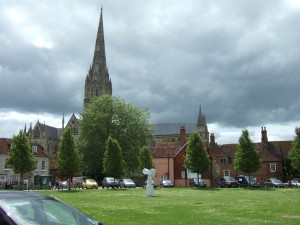
Salisbury Cathedral viewed from the front gate of Mompesson House, 11 June 2014. Peregrines nesting on the spire just out of shot!
In the summer of 1995 I was working on an archaeological project in the storerooms of Salisbury and South Wiltshire Museum, which is also situated in the Cathedral Close. If the weather was good I would eat my lunch sitting out on the Close, enjoying the fabulous surroundings and watching the world go by. One lunchtime I noticed a gaggle of people and equipment outside Mompesson House, and so wandered over. Some sort of filming was in progress, but I didn’t know for what. Lots of people were sitting on the grass and watching the goings-on, so I plonked myself down among them. We were very close to the filming set-up, and I was pleasantly surprised that we were allowed to be so close and were not asked to move back. There were lights and reflectors and cameras and cables and endless crew busying around.
And then as I munched on my lunch, filming started, and Alan Rickman rides up to the house and dismounts. Alan Rickman. In breeches. My sandwich hung half way to my mouth, and my mouth hung open. Alan Rickman. Alan Bloody Rickman. In breeches. Right in front of me. There were other scenes filmed too, with a carriage, but all I could think of was Alan Rickman. In breeches. Right in front of me.
Needless to say, I took a rather longer than usual lunch break and didn’t concentrate too well on my work that afternoon.
I asked around and it turned out that I had witnessed some of the filming for the Ang Lee version of Sense and Sensibility, with Alan Rickman playing Colonel Brandon, and Mompesson House standing in for Mrs Jennings’ London townhouse.
I can’t find any online photos of Alan Rickman in this scene. In 1995 not many (if any?) mobile phones had cameras—in this day and age everybody would be snapping away like crazy. I must rewatch the film and get a screengrab.
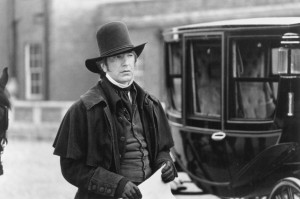
Alan Rickman as Colonel Brandon in Sense and Sensibility (not at Mompesson House: this scene was filmed at Trafalgar House near Salisbury, standing in for Barton Park, Sir John Middleton’s estate).
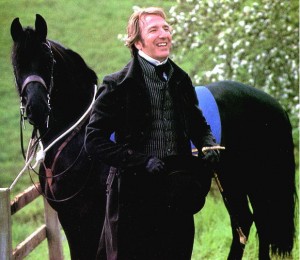
Alan Rickman in Sense and Sensibility. Again, not photographed at Mompesson House: this scene was at the Dashwood’s cottage in Devon, actually a house on the Flete Estate in Devon.
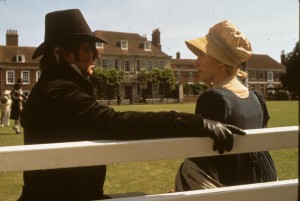
Alan Rickman and Emma Thompson as Elinor Dashwood in Sense and Sensibility. Mompesson House in the background. I didn’t see this scene being filmed. I was probably back in the storeroom, having a fit of the vapours.
I was in Salisbury today so snapped the photo above of the view of the Cathedral from the front of Mompesson House. I wandered over to see if I could see the peregrines—I asked a stonemason working on the east front and he said the nest was on the south face of the spire. I stood by the cloisters entrance and watched for ten minutes or so, but didn’t see anything. I could certainly hear one though, squawking away on the spire. So exciting!
Update 10 August 2014: I’ve just watched the film again and the scene is a blink and you’ll miss it one: it’s when Colonel Brandon is leaving Mrs Jennings’ townhouse to take the Dashwood girls back to Devon: he’s on horseback accompanying their carriage:
The news that the National Trust’s Montacute House and Barrington Court, both in Somerset, will be closed over the next month or so for the filming of a BBC adaptation of Hilary Mantel’s Wolf Hall has given me an idea for a series of posts here on my blog: local places that have been used as filming locations for movies and television programmes.
Montacute House is a stunning Elizabethan house and estate near Yeovil in Somerset, not too far from us and always a favourite to visit. I remember going there a few years ago with Chap and a friend from Canada who was staying with us. We went in April, I think it was—the first day it was open for the season, after its winter closure. The stewards (all of whom seemed to be middle-aged ladies) were all of a tizzy: it turned out that The Libertine had only just finished filming there in the previous few days, and the highlight for the stewards, who were preparing the house for its opening alongside the filming, was seeing the film’s star Johnny Depp. And even better than that, said one, was seeing him wandering around in the nude. I think he made a lot of ladies there very happy!
While walking in the grounds on that visit we noticed a small sign next to the trunk of a large spreading tree. We went over to see what it said—the tree species, maybe?—and as it was so small we had to get right up to the sign to read it. And so, standing almost under the centre of the canopy, we were amused to read something along the lines of ‘Please do not stand under this tree as it may shed its branches suddenly’. Priceless!
Montacute House was also used in the 1995 film of Jane Austen’s Sense and Sensibility, standing in for Cleveland House, the country estate of Mr and Mrs Palmer. (I was lucky enough to witness some of the filming for Sense and Sensibility at Mompesson House in Salisbury – but that’s for another blog post!)
I’m looking forward to Wolf Hall very much – I thought the books on which it is based (Wolf Hall and Bring Up the Bodies) were terrific, and it has a cracking cast, including Mark Rylance, Damian Lewis, Joanne Whalley, David Bradley, Jessica Raine, Mark Gatiss, Claire Foy, Jonathan Pryce, Anton Lesser and Saskia Reeves, among others.
If you were planning a visit, Montacute House is closed until 11 June and Barrington Court from 18 June – 2 July. More details on the National Trust website pages: Montacute Estate; Barrington Court.